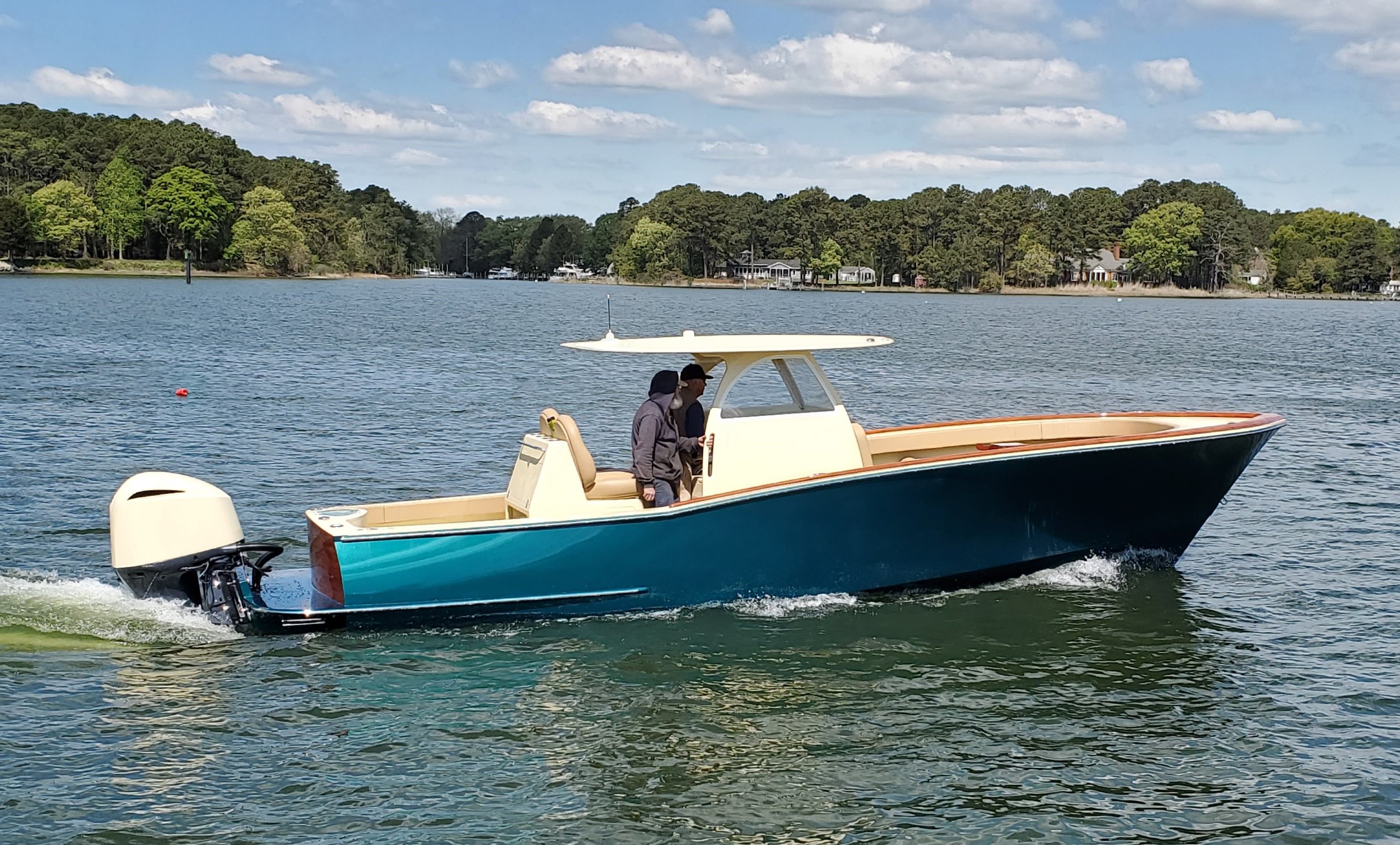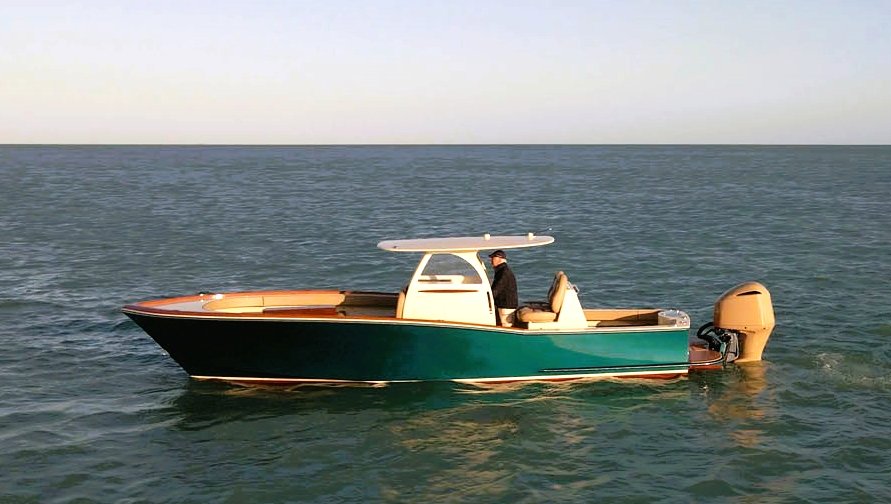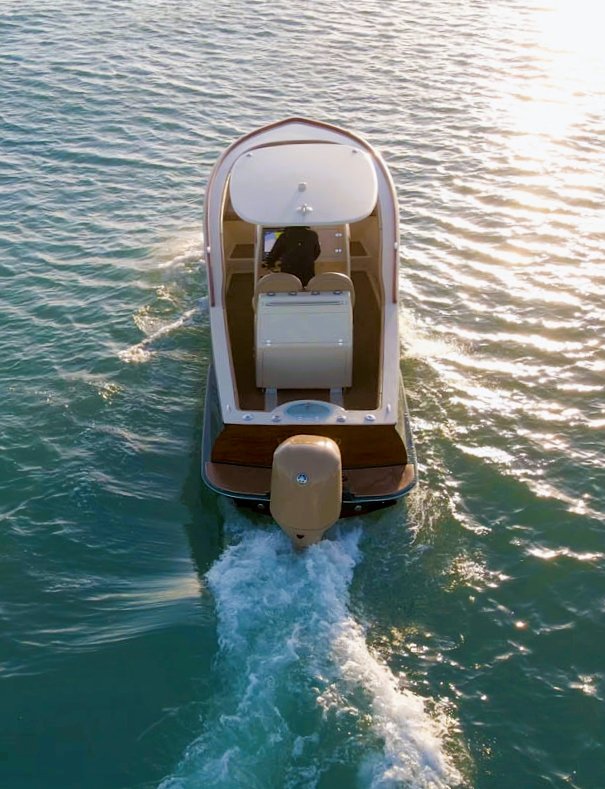Building Emerald: An Owner’s Story
by Shep McKenney
When I was fifteen years old I had saved enough money to buy a five horsepower Sea King outboard motor from the Montgomery Ward catalogue, freeing me from having to row my grandfather’s fourteen foot cypress skiff. While I now had greater range and speed (about eight miles an hour), there was something unsatisfying about how the boat moved through the water with the stern sucking down and the bow pointing up, throwing a big wake.
After a year of this I inherited a derelict, partially rotten plywood skiff that was the same size as the cypress boat but with a completely flat bottom and much lighter. While it performed much the way the other skiff did – stern down, bow up – I could feel it telling me that it could do much more. The only thing I could think of was to get my hundred pounds of weight forward, so I taped a five foot piece of bamboo to the tiller so I could sit in the middle of the boat and still steer.
Sixty-five years later I can still feel the thrill of what happened next. The bow came down, the wake flattened out, and the motor, freed from trying to dig a hole in the water, went from a grind to a whine, and the speed doubled. Feeling that wind in my face as the boat came on to a plane was a breakthrough to transcendence, spawning a lifelong passion for what boats could do and be. Even today, I am prone to reckless driving if I am on the Interstate and see a boat, no matter how pedestrian, being towed several lanes over, and I’ve just got to get over there to see what it looks like up close.
That passion led to a forty year career in the boating industry, first with Hinckley and then with Seakeeper, always focusing on technology and beauty. In other words, I wanted to create boats that looked better and performed better.
After retiring in 2018, I decided to build one last boat that would roll up much of what I had learned to love about boats. Having owned a number of center console outboard boats, I knew I wanted the functionality of that platform. But I also knew that I was not satisfied with the way they looked, their T-tops supported by framework of metal pipes reminding me of the busyness of early biplanes with their wires and struts. So, a goal was to make the windshield and T-top organic to the rest of the boat.
The hull above the waterline was set thirty years ago, when, in an abortive boatbuilding project, I had gotten Naval Architect Bruce King to help me design a Carolina style hull with moderate flair at the bow and graceful tumblehome at the stern. Its shape has always been a dream to me.
Below the waterline, I also knew what I wanted – a soft ride. The obvious way to get that was to give the hull radical deep “V” sections, even beyond the so called deep V hulls that are so common in the marketplace today. The danger with taking this too far is that the boat becomes unstable, both at rest and at speed. Fortunately, because of technologies that I had been heavily involved in developing, I believed there was a way address that danger. The Seakeeper gyro would eliminate zero and low speed roll, and the (just introduced) Seakeeper RIDE motion control system, with its real time (one hundredth of a second) response, would stabilize the boat at speed in both pitch and roll. So, with the help of Oceans 5 Naval Architects, we grafted the radical hull bottom to the Bruce King topsides.
There was another innovation that I wanted to incorporate. Having used GPS controlled electric trolling motors on a number of boats, I couldn’t stand doing without their ability to silently park the boat over one spot on the water, regardless of wind and tide – no more anchoring. But what I also could not stand was the ungainly look of the trolling motor control head, shaft and motor parked on the bow of the boat – more biplane busyness. So we engineered in a trolling motor that was completely encapsulated in the hull and cocktail table pedestal, deployed thru the bottom of the hull.
But where to go to get such a radically different boat built? Here again, the issue was not in doubt. I had known Steve Zimmerman for thirty years and admired the boats he built and how he ran his boatyards and thought he would be energized by such an unusual project for a demanding owner. What I did not know was that I wasn’t just getting Steve, but also Mitch Krom who Steve assigned to head up the effort. Simply put, Mitch is an astonishingly creative and capable craftsman who was a joy to work with.
In the event, it took three years to get this 28 foot outboard boat planned and built. That’s long enough to create a sizable mega yacht. Yet, I never felt impatient or frustrated. I was enjoying myself way too much for that.
Here’s how it worked: Starting with the lay-down (the first step in creating a hull from scratch) I would make the two and a half drive to the Zimmerman Yard in Mathews Virginia from my home in Maryland every month to review progress and tweak design elements. But when I arrived, the first step was not the review, but Mitch and I sharing our most recent fishing adventures and our sizable store of unprintable jokes. Surely, Mitch and I will be reunited in redneck heaven. Steve quickly adapted to this situation and was patient and tolerant until we got down to business.
And what a business it was. Steve and Mitch quickly latched on to the look and feel I wanted, and made suggestions that made the boat much better than it would have been otherwise. They were particularly persistent and creative in doping out the trolling motor. Yet, there were times when we had different ideas about how to proceed, and it all had to be thrashed out. Sometimes it would be two against one, and sometimes three different ideas. Often, one of us would secretly lobby another against a third. All’s fair in love, war and boatbuilding. Good fun all around.
So what it the result of all this time and effort? Because of her striking green hull color I named her “Emerald” and am so pleased with the way she looks that I will drive down to the dock just to look at her and remind myself that she’s real. Wherever I take her, she attracts so much attention that the guy who trailers her to various locations says it’s “like towing a naked woman around”.
The trolling motor setup, after many trials and tribulations, works like a charm. My radical hull actually does what I hoped it would do, providing a remarkably soft ride. My wife, Pat, and I are spending many happy hours on Emerald in Maryland and Florida, not getting beat up to get where we want to go, and, with the trolling motor, silently parking in pretty spots, enjoying the wine and snacks which are standard equipment.
Of course, like all boats, Emerald wants attention, requiring me to take her home to the Zimmerman yard for maintenance, where I get to renew my friendship with Steve and Mitch.
My career in the boating business, for all that was accomplished, couldn’t be called idyllic, involving many difficult, scary times. Building and using Emerald was, and is, idyllic.






